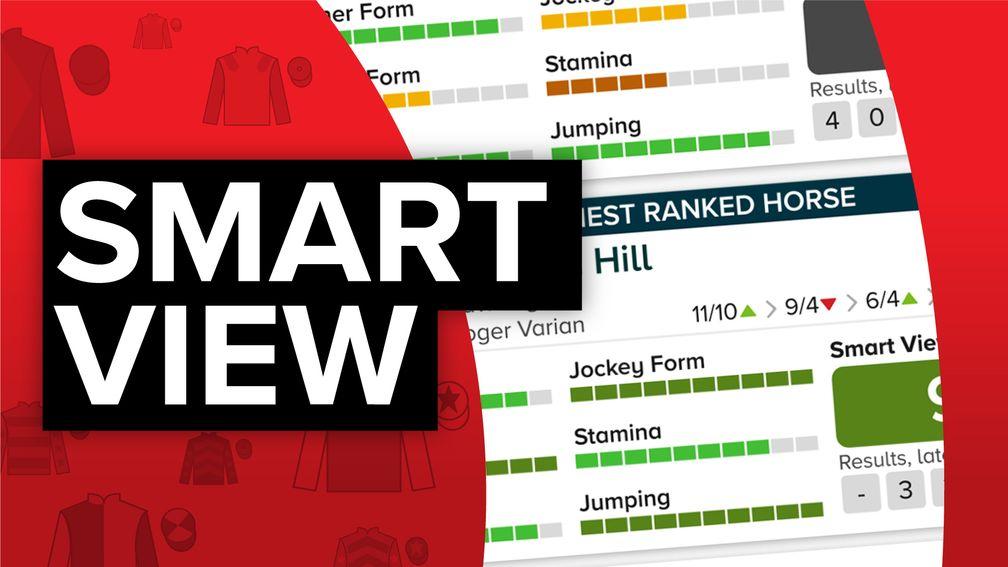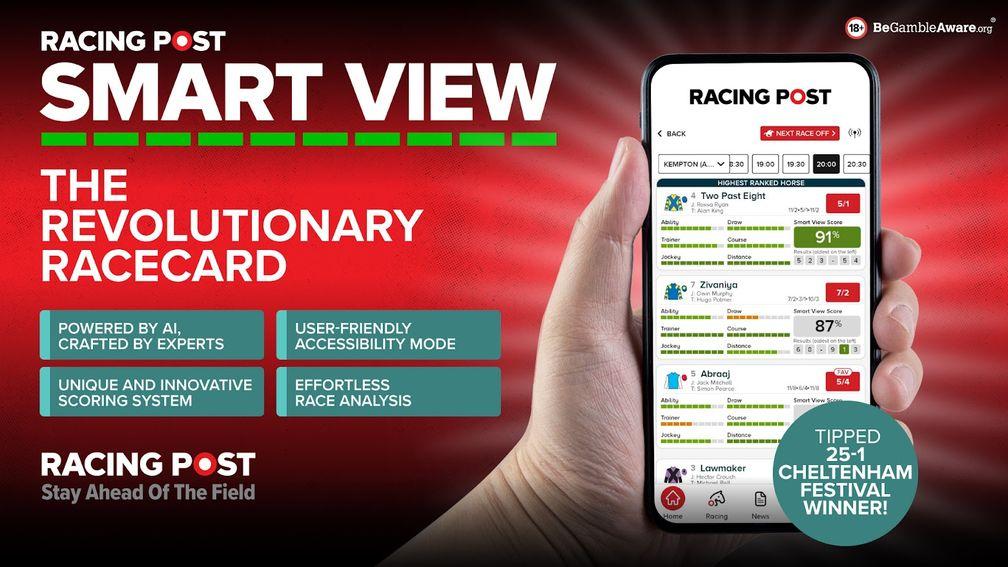How Smart View recorded a 76 per cent profit at the Cheltenham Festival

Smart View is the revolutionary new racecard from the Racing Post, now available on our mobile app, having previously been live only on our digital betting shop display found in some retail bookmakers. In this article, our betting editor Keith Melrose reveals how Smart View unearthed a series of big-priced winners at this year's Cheltenham Festival. You can learn more about how to use and understand Smart View here
You do not need a complex algorithm to tell you that Dan Skelton is a trainer to side with in the County Hurdle, the major handicap on the last day of the Cheltenham Festival. He won the race in only his third season with a licence and since then has won it three more times in eight years.
Coming into the 2023 County, the market latched onto Skelton once more. His Pembroke had all the hallmarks of a plot job. Stable jockey Harry Skelton was up and Pembroke was popular from a long time in advance of the race. He went off 9-2 favourite in a field of 24.
But the market had got wrapped up in Pembroke and missed something, which is understandable in such a big field. Skelton had won the County with a second-string before, Mohaayed in 2018. In 2023, Faivoir was the second string but he was jointly top-rated on weight-adjusted Racing Post Ratings, having dropped 9lb in the weights on the back of just two runs that season.
Faivoir was also ridden by the Skelton stable's second jockey, Bridget Andrews. She had already ridden a County Hurdle winner for the yard and had been on West Balboa when he had won a Premier handicap hurdle at Kempton a couple of months earlier. Andrews had also ridden Faivoir for two of the four biggest performances of his hurdling career, according to Racing Post Ratings.
Smart View's engine picked up on every single point made above. We know this because they are all allowed for in the logic the system has been trained on.

The presence of Andrews on Faivoir was a mild negative compared with Pembroke. Harry Skelton scored 99 on the 100-point jockey scale that day, Andrews 75. But Faivoir being so clearly well handicapped, as well as having a field-leading course score of 94, was deemed more powerful. His Smart View score of 93 was the best in the field.
If you did not know, then you have probably guessed that Faivoir won the County Hurdle that day. His starting price was 33-1.
Since the team behind Smart View had first put it out into the world, we had been using a three-word mission statement: unbiased, comprehensive and intuitive. That might be the sign above the door, but we have learned along the way exactly how some of those terms manifest. Faivoir told us something about how Smart View's unbiased approach can find angles the market is too busy to unearth.
It also told us how a comprehensive system can help in putting punters' qualms into context. Have you ever avoided backing a horse because Bridget Andrews, rather than Harry Skelton, was aboard? I admit that I have. On the Melrose scoring system, which is thankfully not real let alone being released to the public, Skelton is perhaps a 90-ish jockey and Andrews more like the low-60s.
By 'remembering' Andrews' previous form in big handicap hurdles and her record on Faivoir, Smart View's engine narrowed the gap. It gently suggested that maybe this was a day to put a personal hobby horse to one side.

Punters can also get wound up about a horse's best trip. In the recent Pertemps Final, on the third day of this year's Cheltenham Festival, a set of famous silks burst through the pack on the approach to the last. Sat in the press room, I wondered aloud: 'What's John Hales got in this race?'
It was Monmiral who had embarrassed me. Smart View had him the top-rated in the race. Meanwhile, my human thought process had gone thus. I saw Monmiral's name on the card. The bit of my brain reserved for telling me Monmiral is a short-runner sprang into action. I ran this beside the fact of the Pertemps Final being over three miles, and I moved on to the next horse. Plenty of others must have done the same as he won at 25-1.
Smart View decided that the three-mile trip just was not that important in the grand scheme. Looking at Monmiral's record as someone who helped design Smart View's logic but wrote none of the code, I cannot see many positives. But there was also a lack of outright negatives, as well as a more encouraging run on his most recent start which was over the same trip.
When I went back and looked in my personal notes from Monmiral's runs earlier in the season, I was surprised to find that I'd been more equivocal on his lack of stamina than I'd assumed. But when going through a 22-runner handicap, that nuance was lost. He got the red pen from this fallible human, such short shrift that I had forgotten he was even running.
Smart View's engine gave the trip the attention it deserved. 'Distance' was still Monmiral's weakest attribute in the Pertemps Final. It just balanced the various factors and allowed the positives - top connections, favourable ground conditions and a reduced handicap mark - to speak louder.
For some reason, handicap hurdles appear to be a particular area of strength for Smart View's engine. Its other big success at the most recent Cheltenham Festival was Langer Dan, who won his second successive Coral Cup.
The engine has a propensity to like defending champions. That clearly is no bad thing. Smart View is not true artificial intelligence, but a set of logic tests on a huge number of factors. It weights them according to a mixture of experience and training, and expresses the balance as a score. It is therefore a pattern-recognition system, and what pattern could be stronger than a horse returning to a race it has won before?
Those big wins in handicap hurdles helped Smart View to record impressive figures at the most recent Cheltenham Festival. If the main competitor to Smart View is backing SP favourites, what forecasters would call the 'naive forecast' in the game of picking winners, the engine smashed it. Backing all favourites at Cheltenham had a return on investment of -33 per cent. Backing the Smart view top-rated had a ROI of 76 per cent.
But this is not just the result of a chaotic system landing on a couple of lucky winners. Smart View's strike-rate was also strong, with a 30 per cent return across the week that matched favourite-backers.
The system rarely overlooks the obvious. Combine that with the insight you get from selections like Monmiral, Faivoir and Langer Dan and it starts to become clear how anyone can use Smart View. Casual bettors know the data contained within the bars and the scores is tried, tested and independent from direct human opinion.
More experienced punters can turn form study into a one-person brainstorming session. We can all use the detailed outputs of Smart View's engine to challenge our own assumptions, even if it is a second's pause before putting the red pen through a supposed non-stayer.
Read more like this:
Smart View is available on the Racing Post app - how to read the revolutionary new racecard

Introducing the new revolutionary Smart View racecard, powered by AI and crafted by experts. Take a look on the Racing Post app now
Published on 5 April 2024inNews
Last updated 13:18, 5 April 2024
- Merci Olivier! No final winner for Olivier Peslier but the world of racing unites in saluting the end of a great career
- The latest edition of the Racing Post is available to read online now - here's how you can access it
- Smart View is available on the Racing Post app - how to read the revolutionary new racecard
- Levy reform talks 'accelerating' as clock ticks down to April deadline for agreement
- Kieran Shoemark lands another plum Meydan ride for Gosden stable on Trawlerman in Saturday's Dubai Gold Cup
- Merci Olivier! No final winner for Olivier Peslier but the world of racing unites in saluting the end of a great career
- The latest edition of the Racing Post is available to read online now - here's how you can access it
- Smart View is available on the Racing Post app - how to read the revolutionary new racecard
- Levy reform talks 'accelerating' as clock ticks down to April deadline for agreement
- Kieran Shoemark lands another plum Meydan ride for Gosden stable on Trawlerman in Saturday's Dubai Gold Cup